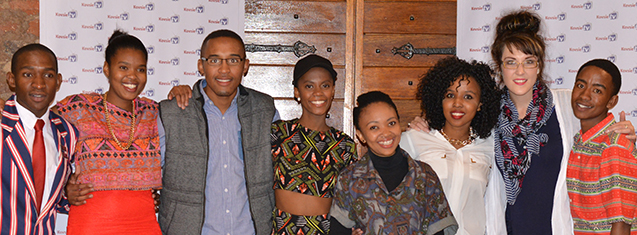
Victor Ngubeni, Grace Thoabala, Nangamso Dlatu, Aisha Poswa, Lesego Maakamedi, Nothando Hlope, Aldene vd Merwe and Lawrence Siyoko
“We have to change our university before we can change our country.”
There is a revolution at hand, and students are requesting new and exciting platforms on which they can voice themselves. Kovsie TV aims to do just that for Kovsie students.
As a student initiative, the steam behind it is SRC Student Development and Environmental Affairs, Victor Ngubeni. He says that it is only right that it be by the students themselves. The launch saw many from the campus community gathered out of curiosity and excitement for the new venture. The evening started out as quite a classy frenzy, which had attendees clearly prepared for the level of broadcasting that the launch would showcase.
The initial idea is to increase the number of platforms where students can receive information. The Student Media portfolio, which oversees the functioning of student media platforms, aims to make Kovsie TV as autonomous as possible. As an introductory initiative, it will aid in the sharing and telling of students’ stories.
It is important to mention the preparation process that was endured by the many hopefuls who auditioned, hoping to make it as one of the Kovsie TV presenters. For more than three weeks, the panel of judges sieved through the contestants until they had just six rough diamonds. Then, for the first time, the audience met the faces that they would become familiar with from this point.
As Ngubeni stressed during his speech, Kovsie TV would not serve as propaganda machine for the SRC, as many might have asked about the relationship that could be expected between the two. The architects of Kovsie TV hope that, as a student initiative, it will inspire a new era in student activism.
When asked about the concept behind this new platform, Ngubeni informed us that, “the concept is to have a twenty-minute campus TV show highlighting what goes on around campus so that students know, and so that we can get them participating in campus life activities.”
This is a student initiative whose future will depend solely on the students themselves.
Presenters:
Nangamso Dlathu – Studio presenter
Grace Thoabala – Studio presenter
Lesego Maakamedi – Social events
Nothando Hlophe – Current affairs
Aldine van der Merwe – Culture events and Vox-Pop
Mbulelo Siyoko – Culture and Vox-Pop
Aisha Phoswa ? Sports